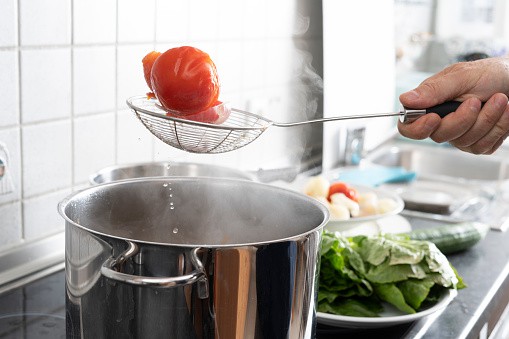Tomatoes are also very tasty and necessary in many dishes. Add a few of them to your food and your food won’t let you down. I believe this article will help the reader if they have doubts about the right time to plant tomatoes or are thinking of getting a small garden.
This is the best site to visit if you want to start growing tomatoes in your farm and is not sure about the time that can be suitable for the activity. Our objective is to assist you in gaining an overall picture of the needs of tomato-growing.
Tomato plants are not frost-hardy and as such warm season in nature. For this reason, it is crucial that the seeds are not planted too late. Even so, this will also depend on your region.
Most of the places temperature of the soil will still be too low to allow for the growing of tomatoes outdoors late spring or early summer.
Tomatoes also exist in a wide range of varieties and this may impact on the planting time as some tomatoes may be more seasonal compared to others. Starter plants are often an option if you are a gardener and don’t want to start seeds themselves or if they instead want to transplant seedlings.
On the other hand, if you do not have transplants and plan to grow from seeds then you can continue your process of planting indoors until the external soil is warm enough to support such young plants.
When Should You Plant Tomatoes?
As we already mentioned, when to plant tomatoes depends on your region. These plants are long-season and heat-loving. The time you start planting will also be determined by whether or not you plant tomatoes from seeds or seedlings.
When to Sow Tomato Seeds Indoors
Tomatoes germinate around 64°F (18°C)- 77°F (25°C). Therefore, it is recommended to plant the seeds covered whether you plan to grow them in a greenhouse or outside.
If you plan to transplant them outside, you can plant tomatoes six to eight weeks before the latest frost date in your area.
Sow thinly in seed sowing compost-filled trays, loosely cover with compost and water. Seeds will germinate in about eight to ten days if kept in a bright area at roughly 65°F (18°C) – preferably in a propagator or covered with a plastic bag. If you only want to grow a few plants, sow them separately in little pots.

Image: Modern farmer
At this stage, the two ‘actual’ leaves should be removed and new seedlings moved to 9 cm pots to be potted on if they have started growing and then planted outside. After germinating the seedlings continue to maintain a well-lit environment for 10-14 hours a day. It is not necessary to wait for the standard seasons; one can even grow plants in winter using the artificial grow light.
Continue to water your seedlings but not overwater them. If you put the seeds in earlier than you should, they will likely need to be moved to another pot before they are planted in the ground.
Place the pots outside on a sheltered planting spot when the growing medium on the outside develops suitable temperatures for the young tomato plants. This for an hour every day for one week or two until your plants have become to the new temperature and light condition of the outdoors.
When to Plant Tomatoes Outside
When should you plant tomatoes outside? This may be a tricky question; however, it is simple. First, you should wait till the risk of frost has passed and the weather conditions are favorable, and the soil is warm.

Image: Freepik
Tomatoes are normally transplanted one to four weeks outdoors following your area’s last frost date. Most tomato plants are replanted outside once the lowest overnight temperatures are slightly above 50°F. This normally happens a few weeks from the last first frost date in the area.
If you plant tomatoes outside when the nighttime temperature is below 50°F, the plants grow very slowly. When the temperatures reach below 43°F, the seedlings may get damaged.
Tomato Plant Problems
Once you plant your tomatoes, they will likely encounter diseases and pest infestation challenges. So, ensure you watch out for infections and infestations, which are sometimes caused by excessive use of fertilizers. Some of the tomato plant diseases include the following;
i). Powdery Mildew
Powdery mildew is a fungal disease that leaves the tomato leaves with white spots or a dusting of white. This disease is manageable and doesn’t have to worry you.
ii). Cracking
When the fruit is grown too fast it will split resulting into laboriously opening the skin. This is often caused by alternating between dry or wet seasons, as well as (extreme periods of rainfall and dry spells). Watering and mulching must be done on regular basis to ensure that the air moisture level is maintained.
iii). Mosaic Virus
Causes distorted leaves and early growth to be narrow and twisted, as well as yellow mottling on the leaves. Unfortunately, diseased plants must be destroyed (but not composted).
iv). Early Blight
Early blight is a fungus that forces leaves to fall off, and because of the humid conditions and high temperatures in July, the risk of blight increases. It begins with dark, concentric patches (brown to black) on the lower leaves and stems about 1/2-inch diameter.

Image: ncsu
If you detect the disease early, your plant may survive after you kill the contaminated leaves. Good ventilation and removing the lower leaves as the tomatoes mature are the best defenses for outdoor tomatoes.
This also aids ripening because tomatoes receive the most solar exposure.
v). Late Blight

Image: Gardentech
Late blight is a fungus that causes grey-fungous wounds on fruits and leaves; the wounds later turn brown. The dampness of the weather ensures that the disease is widely spread. Sadly, once the fungus is caught from your tomato, there little one can do.
vi). Blossom-End Rot
This disease occurs due to decreasing or increasing the calcium in the plant and results in the formation of dark and sunken areas on the portion of the tomato plant that is back side. Calcium deficiency is usually as a result of watering imbalance and this can be avoided by ensuring the soil is moist but not to a flowing stage.
How Can You Prevent Tomato Plant-Insect Infestation?
Besides crop diseases, we already mentioned that pests could infest tomato plants. However, before that happens, you will need to try some preventative measures to ensure your plants do not get manifested by pests.
a). Rotate crops after at least three years and try as much as possible to avoid other members of the tomato plant. Such plants include eggplants and pepper
b). Do not plant just any crops; instead, plant disease-resistant crops. Such crops are usually coded and listed on the seedling or seed packet.
c). When planting tomatoes, ensure you use well-draining soil. Also, mix in compost or organic matter.
d). Solarize your soil; if the problem is too much, you can treat it by using plastic to cover the soil during the hottest summer days for 6-8 weeks. This will give the sun time to destroy the bacteria.
e). When you see infected plants, destroy them as soon as possible. This will prevent the pests from spreading to uninfected plants. Be careful not to put the discarded plants in the compost pile.
How Can You Get the Timing Right When Growing Tomatoes?
To find out the best time to plant your tomato seeds and plants, you can start by figuring out when you plan to plant them outside and calculating backward. So let’s find out how to do that.
1. Calculate the Optimal Planting Date
The foremost thing to remember here is the planting should be delayed until the last frost of the season according to your USDA Hardiness Zone.
It can be difficult but it is still important to wait until the weather is warmer even if you have unseasonably warm weather if you want optimal gardening results.
Tomatoes are purely summer crops and cannot tolerate cold; planting them too early could be detrimental to them. However, a few transplants may be able to survive a few chilly nights but the growing process might be slowed and such plants will be vulnerable to diseases and pests.
It should be noted that first and last frost dates are only estimates based on your growth zones.
2. Temperature
Tomatoes need night temperatures to be consistently above 50°F. You can use a soil thermometer to confirm. However, if you do not have a thermometer, you can use a makeshift method whereby you stick your finger in the soil; and if you can’t stick it there comfortably for a minute, the soil is probably too cold.
3. Days to Maturity
While it could be safe to plant after the last frost, waiting a few weeks till the temps have warmed and the days have lengthened may result in better, happier plants.
However, some varieties take a long time to mature, and it’s just as critical to ensuring there will be enough warm days for crops to produce fruit before they’re damaged.
First, you will need to figure out when you expect the first frost to fall. Then, use the number of days to maturity to count backward. The number of days to maturity is often indicated on the packet of seeds.
4. Sunshine
Tomato plants need enough sunshine to be healthy. Before planting tomato plants, ensure the sun is high in the sky for a large part of the day to receive at least six hours of full sun exposure.
Image: Fromseedtocrop
















